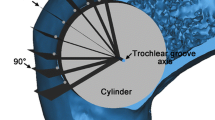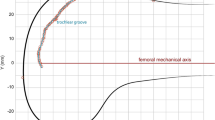Abstract
Background
In the natural and prosthetic knees the position, shape, and orientation of the trochlea groove are three of the key determinants of function and dysfunction, yet the rules governing these three features remain elusive.
Questions/Purpose
The aim was to define the three-dimensional geometry of the femoral trochlea and its relation to the tibiofemoral joint in terms of angles and distances.
Methods
Forty CT scans of femurs of healthy patients were analyzed using custom-designed imaging software. After aligning the femur using various axes, the locations and orientations of the groove and the trochlear axis were examined in relation to the conventional axes of the femur.
Results
The trochlear groove was circular and positioned laterally in relation to the mechanical, anatomic, and transcondylar axes of the femur; it was not aligned with any of these axes. We have defined the trochlear axis as a line joining the centers of two spheres fitted to the trochlear surfaces lateral and medial to the trochlear groove. When viewed after aligning the femur to this new axis, the trochlear groove appeared more linear than when other methods of orientation were used.
Conclusions
Our study shows the importance of reliable femoral orientation when reporting the shape of the trochlear groove.




Similar content being viewed by others
References
Aglietti P, Buzzi R, Gaudenzi A. Patellofemoral functional results and complications with the posterior stabilized total condylar knee prosthesis. J Arthroplasty. 1988;3:17–25.
Arima J, Whiteside LA, McCarthy DS, White SE. Femoral rotational alignment, based on the anteroposterior axis, in total knee arthroplasty in a valgus knee: a technical note. J Bone Joint Surg Am. 1995;77:1331–1334.
Barink M, van de Groes S, Verdonschot N, de Waal Malefijt M. The trochlea is bilinear and oriented medially. Clin Orthop Relat Res. 2003;411:288–295.
Barink M, Meijerink H, Verdonschot N, van Kampen A, de Waal Malefijt M. Asymmetrical total knee arthroplasty does not improve patella tracking: a study without patella resurfacing. Knee Surg Sports Traumatol Arthrosc. 2007;15:184–191.
Bull AM, Katchburian MV, Shih YF, Amis AA. Standardisation of the description of patellofemoral motion and comparison between different techniques. Knee Surg Sports Traumatol Arthrosc. 2002;10:184–193.
Callahan CM, Drake BG, Heck DA, Dittus RS. Patient outcomes following tricompartmental total knee replacement: a meta-analysis. JAMA. 1994;271:1349–1357.
Clayton ML, Thirupathi R. Patellar complications after total condylar arthroplasty. Clin Orthop Relat Res. 1982;170:152–155.
Dennis DA. Patellofemoral complications in TKA: a literature review. Am J Knee Surg. 1992;5:156–161.
Eckhoff DG, Bach JM, Spitzer VM, Reinig KD, Bagur MM, Baldini TH, Rubinstein D, Humphries S. Three-dimensional morphology and kinematics of the dorsal part of the femur viewed in virtual reality: Part II. J Bone Joint Surg Am. 2003;85(suppl 4):97–104.
Eckhoff DG, Burke BJ, Dwyer TF, Pring ME, Spitzer VM, VanGerwen DP. The Ranawat Award. Sulcus morphology of the distal femur. Clin Orthop Relat Res. 1996;331:23–28.
Feinstein WK, Noble PC, Kamaric E, Tullos HS. Anatomic alignment of the patellar groove. Clin Orthop Relat Res. 1996;331:64–73.
Freeman MA, Samuelson KM, Elias SG, Mariorenzi LJ, Gokcay EI, Tuke M. The patellofemoral joint in total knee prostheses: design considerations. J Arthroplasty. 1989;4(suppl):S69–S74.
Fulkerson JP, Hungerford DS. Normal anatomy. In: Fulkerson JP, Hungerford DS, eds. Disorders of the Patellofemoral Joint. Baltimore, MD: Williams & Wilkins; 1990:1–24.
Fulkerson JP, Hungerford DS. Biomechanics of the patellofemoral joint. In: Fulkerson JP, Hungerford DS, eds. Disorders of the Patellofemoral Joint. Baltimore, MD: Williams & Wilkins; 2004:25–41
Henckel J, Richards R, Lozhkin K, Harris S, Baena FM, Barrett AR, Cobb JP. Very low-dose computed tomography for planning and outcome measurement in knee replacement: the Imperial knee protocol. J Bone Joint Surg Br. 2006;88:1513–1518.
Huo MH, Sculco TP. Complications in primary total knee arthroplasty. Orthop Rev. 1990;19:781–788.
Kulkarni SK, Freeman MA, Poal-Manresa JC, Asencio JI, Rodriguez JJ. The patellofemoral joint in total knee arthroplasty: is the design of the trochlea the critical factor? J Arthroplasty. 2000;15:424–429.
Lonner JH. Modular bicompartmental knee arthroplasty with robotic arm assistance. Am J Orthop. 2009;38(2 suppl):28–31.
Noble PC, Conditt MA, Cook KF, Mathis KB. The John Insall Award. Patient expectations affect satisfaction with total knee arthroplasty. Clin Orthop Relat Res. 2006;452:35–43.
Rolston L, Siewert K. Assessment of knee alignment after bicompartmental knee arthroplasty. J Arthroplasty. 2009;24:1111–1114.
Senavongse W, Amis AA. The effects of articular, retinacular, or muscular deficiencies on patellofemoral joint stability. J Bone Joint Surg Br. 2005;87:577–582.
Shih YF, Bull AM, Amis AA. The cartilaginous and osseous geometry of the femoral trochlear groove. Knee Surg Sports Traumatol Arthrosc. 2004;12:300–306.
Stäubli HU, Dürrenmatt U, Porcellini B, Rauschning W. Anatomy and surface geometry of the patellofemoral joint in the axial plane. J Bone Joint Surg Br. 1999;81:452–458.
Yoshino N, Takai S, Ohtsuki Y, Hirasawa Y. Computed tomography measurement of the surgical and clinical transepicondylar axis of the distal femur in osteoarthritic knees. J Arthroplasty. 2001;16:493–497.
Acknowledgments
We thank Dr Robin Richards for technical support and designing the 3-D image analysis software that was used in this study.
Author information
Authors and Affiliations
Corresponding author
Additional information
One or more of the authors received funding from the Furlong Charitable Foundation for Research (FI) and the University of Malaya Medical Centre, Kuala Lumpur, and the Arthritis Research Campaign (AMM).
Each author certifies that his or her institution has approved the human protocol for this investigation, that all investigations were conducted in conformity with ethical principles of research, and that informed consent for participation in the study was obtained.
This work was performed at Imperial College London, London, UK.
About this article
Cite this article
Iranpour, F., Merican, A.M., Dandachli, W. et al. The Geometry of the Trochlear Groove. Clin Orthop Relat Res 468, 782–788 (2010). https://doi.org/10.1007/s11999-009-1156-4
Received:
Accepted:
Published:
Issue Date:
DOI: https://doi.org/10.1007/s11999-009-1156-4




